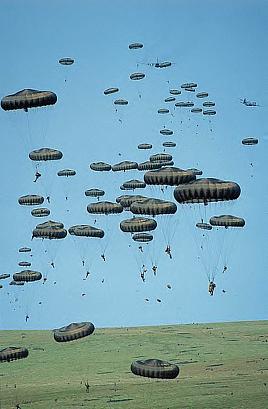
Forming Up 1942 — 1943
The first British airborne division started to form in late 1941 at Bulford at the time that 1st Parachute Brigade and 1st Airlanding Brigade began to materialize. 1st Airborne Division's third brigade, 2nd Parachute Brigade, started to form on 17 July 1942. However, towards the end of 1942, the Division was falling well behind in its programme. 1st Parachute Brigade had deployed to North Africa in November and the newly recruited 2nd Parachute Brigade had lost a number of men who had been transferred to make 1st Parachute Brigade up to strength. By January 1943, 1st Airborne Division had in its order of battle, 1st Airlanding Brigade ready for war, 2nd Parachute Brigade under strength and another brigade, 3rd Parachute Brigade, in its infancy. It must be remembered that this Airborne Division was the only one of its kind in the British Army at this stage. It was called 'The Airborne Division' and the nomenclature '1st Airborne Division' did not come into being until 6th Airborne Division was raised in the spring of 1943. Similarly, Airborne Divisional Signals were not referred to as 1st Airborne Divisional Signals until the same time. To avoid confusion, the Division and their associated signal units have been referred to throughout by their later titles.
1st Airborne Divisional Signals started to form at Beacon Barracks, Bulford, in the spring of 1942. Lieutenant Colonel RJ Moberly was appointed the first Commanding Officer with Major Smallman-Tew as his Second in Command. At the beginning of 1943, the unit was still not up to strength and its organisation at this early stage was far from certain. No experience was available on which to base the organisation. The structure of the Unit was originally designed to support a small and highly mobile force. However, later experience led to a considerable increase in size. Also at this early stage, there were no wireless sets designed specifically for airborne operations. Sets had to be procured which not only met the specific communication requirements of an airborne formation but also were robust enough to survive the rough treatment of being dropped by parachute. Regardless of these difficulties, 1st Airborne Division was ordered on 9 March 1943 to mobilize. Mobilization was completed by 1 May.
North Africa 1943
In April 1943 a second British airborne division, 6th Airborne Division, started to form. It was then decided that the strategic deployment of British airborne forces would include one airborne division in North Africa and one in England. This strategic redeployment catered for plans that were being developed for operations in 1943 and 1944.
1st Airborne Division was thus selected to be deployed to North Africa in April/May 1943. Movement was to be in two main sea convoys. 2nd Parachute Brigade arrived at Oran in Algeria on 26 April and 1st Airlanding Brigade arrived at Mascara on 26 May. 1st Airborne Divisional Signals disembarked at Algiers and established itself at Phillipeville along the coast to the East.

Plate 1. No1 Company 1st Airborne Divisional Signals - January 1943
Taken at Beacon Barracks, Bulford a few months before the Division deployed to North Africa
Click on the plate to enlarge it.
1st Parachute Brigade and its Signal Section, having been in North Africa since November 1942, now regrouped with its parent Division for training, re-equipping and reinforcement. 3rd Parachute Brigade, still in its infancy, remained behind in England and was regrouped with the new 6th Airborne Division.
4th Parachute Brigade and its Signal Section also joined 1st Airborne Division in North Africa in June 1943. As early as September 1941, it had been decided by the War Office that a parachute brigade should be formed in India and that its first battalion should be British. This first battalion was named 151 Parachute Battalion and, for a variety of reasons, it moved to the Middle East in November 1942 where it changed its name to 156 Parachute Battalion. Also in 1942 orders were given to establish the 4th Parachute Brigade in the Middle East. Brigade HQ and the Signal Section (the Signal Section in fact called themselves a troop and unofficially included the words 'Independent' and 'Middle East' in their title but for simplicity these designations have been omitted) began to form at Kabrit, near Fayid in the Canal Zone in December. Major Kennett, who as a subaltern was Second in Command at the time, recalls that the Signal Section had some 40 men, 4 Jeeps and two bikes. Volunteers from the 2nd Battalion The Royal Sussex Regiment and elsewhere were trained as parachutists and formed the second battalion of this new brigade. The Brigade continued to form throughout January 1943 and based itself on No 4 Middle East Training School at Kabrit that had opened on 3 May the year before. Kabrit, however, proved to be totally unsuitable as an airborne training centre; airfield facilities were inadequate and the DZ was too hard for basic training. In addition, the heat, sandstorms and poor accommodation led eventually to the move of No 4 Middle East Training School and, with it, the embryo 4th Parachute Brigade to the Ramat David area in Northern Palestine at the end of February. The Signal Section, commanded by Captain D Curry, was at one stage accommodated in the old Palestine Police barracks in Jenin. It subsequently moved to the Austrian Hospice at Nazareth. By May 1943, the Brigade was up to strength and in June, moved by rail to Port Said, from there by sea to Tripoli in North Africa and on by road to Msaken near Kairouan where it came under command 1st Airborne Division. The Signal Section's journey to North Africa was slightly different from that of the rest of the Brigade. The Section travelled by road from Nazareth to Haifa and by boat on to Tripoli.
By the end of May the US 82nd Airborne Division had assembled in Tunisia. June and July were spent in training and establishing an operational base at Kairouan some 35 miles inland from Sousse.
Invasion of Sicily 1943
The plan for the Allied invasion of Sicily, Operation HUSKY, was almost complete by the end of June 1943. 1st Airborne Division had now regrouped and its order of battle consisted of 1st Parachute Brigade, 2nd Parachute Brigade, 4th Parachute Brigade and 1st Airlanding Brigade.
Brigade should undertake an airborne operation in advance of the leading elements of ground forces and secure the approaches immediately to the south of Catania.
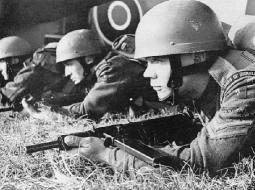
Plate2 - Airborne Signals Recruiting Photograph - 1942
Issued by the Ministry of Information and taken on Salisbury Plain in early 1942. Corporal is in the foreground with other members of 1st Airlanding Brigade Signal Section, (L) is a General Aircraft Hotspur glider. This photograph was taken at about the time the Divisional Signals were forming and was undoubtably intended for use in recruiting men for airborne duties.
Click on the plate to enlarge it.
1st Parachute Brigade launched its operation from Kairouan and the landings took place on the night of 13 July. The operation, however, was cursed by misfortune. Anti-aircraft fire from the invasion fleet brought down a number of aircraft and caused others to return to base. In spite of this, the objectives of the Brigade were achieved although German airborne reinforcements resulted in a bloody battle for the Primosole Bridge. Wireless communications to the airborne base were not established, neither were some of the command links because so many of the wireless sets were missing or damaged. Also, because of the lack of communications, no call could be made for re-supply. As a result of this, it became standard procedure that re-supply would be made automatically unless cancelled by wireless. It also subsequently became standard procedure that no ground force wireless set was allowed to be closed down until some form of communication had been established with the airborne base; and then only if it was agreed by the Chief Signal Officer that the net was unworkable or unnecessary.
Catania fell on 5 August and Sicily was cleared of enemy by 16 August. 1st Airborne Division was back in its airborne base in North Africa by 30 July to rest and to take in reinforcements sent out from England.
Invasion of Italy 1943
Following the Allied success in Sicily and the downfall of Mussolini, the next phase of the campaign was launched. The invasion of the Italian mainland started on 3 September with a landing by the Eighth Army on the peninsula of Calabria (Operation BAYTOWN) followed by a second landing by sea on 9 September involving 1st Airborne Division in the Gulf of Taranto (Operation SLAPSTICK). The US Fifth Army landed further to the north at Salerno also on 9 September.
As part of the general advance, 1st Airborne Division was involved in various minor ground operations along the Adriatic coast north as far as Foggia. In November 1943, the Division was replaced by 78th Infantry Division and withdrawn from the line to leave Taranto by sea for England. 2nd Parachute Brigade, however, remained in Italy under command Fifteenth Army Group so that a balanced force remained in theatre. 2nd Parachute Brigade subsequently expanded into an independent brigade group and its fortunes are related in the notes on 2nd Independent Parachute Brigade Group Signal Company.
It was during this time in Italy that Lance Sergeant Peter Donald Phillips and Signalman Donald Stewart were involved in clandestine operations behind the German lines. Both men formed one of a number of teams which were deployed to link up with recently released Allied prisoners of war. The men dressed in civilian clothes although they made sure they wore enough items of military clothing to prove, if need be, that they were soldiers. They also had with them a 'suitcase' radio set. Sergeant Phillips and Signalman Stewart established on OP in a house which was also occupied by German Signals. From the OP they were able to pass back important information relating to German troop movement. They were also able to keep their batteries charged from the Germans who kept their own batteries on charge all night. Both men were subsequently presented to The Princess Royal during her visit to the unit on 4 March 1944 and shortly afterwards were each awarded the DCM. The small number of cases of private soldiers receiving the DCM underlines the conspicuous conduct of Signalman Stewart. Signalman Stewart was later killed during the Arnhem Operation.
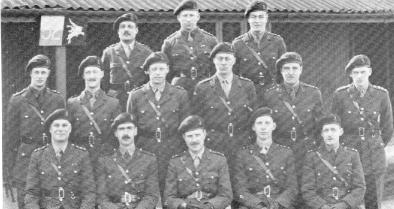
Plate3 - Officers of 1st Airborne Divisional Signals March 1943
Taken at Bulford a few weeks before deployment to North Africa.
Click on the picture to enlarge it.
Preparations in England 1944
1st Airborne Divisional Signals were regrouped back in England in the Fulbeck-Caythorpe area some 12 miles east of Newark-on-Trent by December 1943. Regimental Headquarters established itself at Holycross House in Caythorpe. The Division was ordered to reorganise and train for forthcoming operations in North West Europe. Training and planning was now co-ordinated by the newly formed Headquarters of 1st Airborne Corps. During the next few months there was a considerable change round in officers and senior NCOs. This resulted from an effort to provide the newly formed 6th Airborne Divisional Signals with men who had gained experience in North Africa and Sicily.
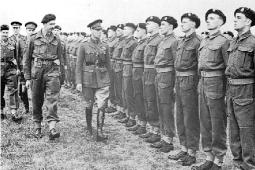
Plate 4. HM King George VI inspecting Signallers of 1st Airborne Division - 2 April 1943
Taken at Bulford shortly before the Division deployed to North Africa. Accompanying the King is Major D Smallman-Tew, Second in Command of 1st Airborne Divisional Signals. Major General GF Hopkinson OBE MC (in beret), who commanded 1st Airborne Division, follows.
Click on the picture to enlarge it.
Lieutenant Colonel T G V Stephenson took over command of the unit in February 1944 from Lieutenant Colonel Moberly who left the Division to become Chief Signal Officer, 1st Airborne Corps.
On 4 March, Her Royal Highness The Princess Royal, Colonel-in-Chief Royal Signals visited the Unit at Caythorpe. The Corps band were present for this special occasion and Colonel Moberly returned to his former unit for the day.
The end of April was marked by a large exercise {Exercise EVE) held in the area between Oxford and Bristol. The exercise involved 6th Airborne Division in the airborne role, 1st Airborne Division acting as enemy and the whole being co-ordinated by HQ 1st Airborne Corps. Lieutenant Colonel Stephenson recalls that his capture on the exercise created considerable amusement, much to his chagrin. The exercise proved particularly valuable to 6th Airborne Division who by this time had mobilized and were preparing for the forthcoming Allied invasion of Western Europe.
The hard won experience in North Africa and Sicily had taught some important lessons about signals organisation and tactics. For example, every vital wireless link needed to be duplicated and specialist functions such as Signal Office and Cipher capabilities had to be widely dispersed to avoid total loss in any one accident. At Figure 1 in Appendix 2 is the organisation of Airborne Divisional Signals showing how it had developed by 1945. At Figure 2b in the same Appendix is a typical organisation of a Brigade Signal Section and its wireless diagram. The airborne jeep with its trailer was the basic means of transport and was brought in by glider. Communications were in the main by wireless and equipment was on a lavish scale with vital nets having 100% duplication. On deployment, part of the Division HQ landed by glider and each glider had a carefully worked out load. For example, the Commanding Officer had with him in his glider his batman, 3 wireless operators, 1 cipher operator, 3 linemen and a jeep that acted as the GOC's spare, a trailer carrying a spare WS No 76 and a handcart for line. The AA & QMG on the other hand had a clerk, the Cipher Officer, 5 operators, 1 DR, a jeep containing a WS No 62, a trailer containing a WS No 76, 3 miles of cable and a 'quarter' of the Signal Office.
In Reserve 1944
By April 1944, 1st Airborne Division had completed its regrouping on return from North Africa and, after numerous exercises, now stood ready for any operation in Western Europe that it might be called upon to undertake. Morale throughout the Division was particularly high and everyone was itching to be off again.
The final touches to the Normandy invasion plan were being added throughout April and May until finally on 6 June the invasion was launched. 21st Army Group landed on the beaches of Normandy with 6th Airborne Division protecting the left flank and securing the bridges over the River Orne and the Caen Canal. The news of these successes made the men of 1st Airborne Division even more impatient to be involved. However, 1st Airborne Division remained in England as a reserve for 21st Army Group. Numerous plans were developed for committing this reserve but they were subsequently abandoned when there remained no tactical reason to deploy the Division. On one or two occasions the Division actually loaded up the aircraft only to be told at the last moment that the operation had been cancelled. In August, HQ 1st Allied Airborne Army was established to co-ordinate the three US and two British Airborne Divisions that now were in the theatre and in reserve. A month later the full resources of 1st Allied Airborne Army were placed at the disposal of 21st Army Group who were now well and truly established on the continent.
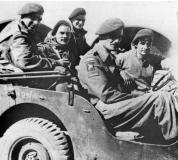
Plate 5. Members of P Section, 1st Airborne Divisional Signals attached to
21st Independent Parachute Company (Pathfinders) - June 1943
Taken in North Africa near Kairouan shortly before the invasion of Sicily. From left to right: Cpl. Bennett, not known, Sgt Markendale, Lt Campbell (OC Sect), Sig Airey.
By courtesy of F W Weatherley, formerly of 21st Independent Parachute Company
Click on the picture to enlarge it.